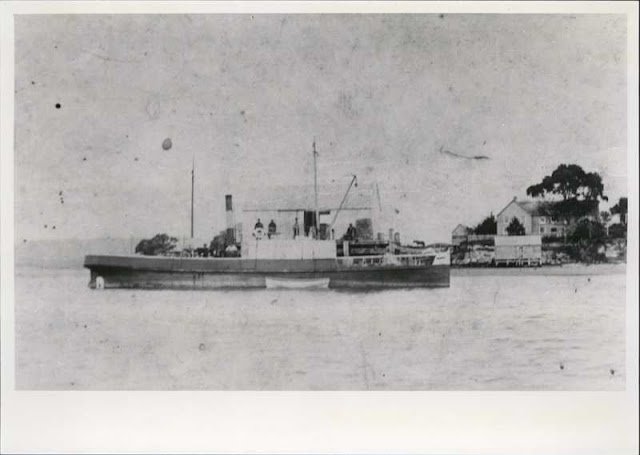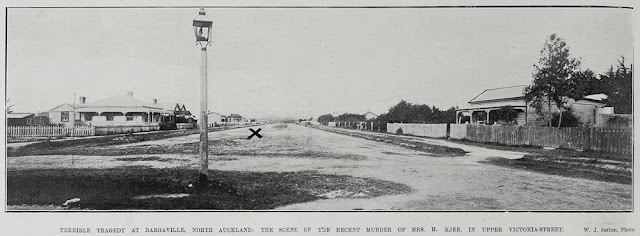The wreck of the ss Ruby (Mangawhai 1893)
 |
| "Ruby" at Mangawai.,Unknown, photographer,ca. 1890,PH-TECH-576-14 |
On March 31, 1893, the coastal steamer ss Ruby came to grief on the rocks at the head of the Mangawhai Harbour entrance with the loss of two lives.
The Ruby was constructed in 1876 as a paddle steamer by Robert Stone at Shortland, Thames for Captain Stanier Henry Burningham for the Ohinemuri trade. 31.84//20.07 tons register, fitted with two engines for a capacity of 30hp; she measured 75.8 x 11.6 x 5.1 feet and had a cutter rig. She was launched on August 22, 1876.
The new paddle steamer lately built by Mr R Stone at the Thames, for the Ohinemuri trade arrived here last night from the Thames for the purpose of getting measured and registered by the Customs Authorities. The Ruby is a very useful little, boat admirably adapted for the traffic for which she is intended ... The engines are direct acting; diameter of cylinders being 10 in, and the length of stroke 24 inches. The paddle wheels are 10ft 6in. in diameter; the boiler is on the locomotive principle, and made of the best Lowmoor iron; it is weighted to a pressure of 90lbs to the square inch A speed of nearly ten knots is expected to be attained when in proper trim. She came up last night in a little over five hours under unfavourable circumstances. Her cabin accommodation is very good. She has a fine roomy saloon aft, measuring 18ft 6in long. This is prettily decorated and upholstered with horsehair cushions. Light is admitted by a skylight extending the whole length. A table occupies the centre, capable of seating 18 people There is another cabin fore ward about 12ft long, intended for smokers. The after cabin is intended for ladies, but not exclusively. On deck, we notice a house containing all the necessary offices, including galley, bar, separate closets for ladies and gentlemen (these are kept supplied with water by a simple contrivance in connection with the paddle wheel) store cupboard &c. The Ruby does great credit to her builder and should prove a paying boat, though as regards this, more depends on the mines than the boat. The Ruby will run between Grahamstown and Paeroa, and will as nearly as practicable make a daily trip.
 |
| Thames Star 4 February 1878 Page 2 |
By 1879, a mere three years after she was built the Ruby was suffering from a drop off in trade and patronage and was put up for sale.
 |
| New Zealand Herald 20 October 1879 Page 1 |
In 1880, the vessel was laid up and stripped of her engines, which were later placed into a new steamer built by the Price brothers for the Thames River Steam Navigation Company named Patiki.
 |
| Thames Star 12 March 1881 Page 3 |
In 1881, the Ruby was put up for tender by her owners the Thames River Steam Navigation Company. by 1882, the vessel had been purchased by WH Briggs and refitted into a screw steamer.
The p.s. Ruby, built by Mr Robert Stone, of the Thames, several years ago, for Mr S H Burningham, to be employed on the Ohinemuri trade, has been converted into a screw steamer, making her trial trip yesterday afternoon. Like all Mr. Stone's vessels, the Ruby is a strongly and faithfully built boat, but owing to some mistake, to whom the responsibility for which attaches is of no moment, she was not such a success as was anticipated, the chief fault being that she rolled unduly. However, she ran for a considerable time in the trade for which she was intended ; in fact, until it fell oft so much as to be unremunerative. The Ruby afterwards became the property of the Thames Navigation Company, from whom the present owner, Mr. W H Briggs, a young man who arrived in this city little over three years ago, bought her. In process of time, a great change came about. The paddles being removed, the mode of propulsion will be by a screw. This will be driven by a high-pressure engine, of about 14 horse-power nominal. It has an inverted cylinder, 11 inches in diameter, with a 12-inch stroke. The Ruby, we believe, is the first boat in the colony which has been provided with Scott's boilers —a patent emanating from Calcutta, Several large vessels .have been furnished with these boilers, and it is said they have given thorough satisfaction. The Ruby has a pair, with a working pressure of 90lbs to the square inch. Nor has less attention been given to the accommodation and comfort of passengers than to speed and stability. There is a saloon on deck, for gentlemen, which is oak grained, the ceiling being painted white. The seats are swung, so that they may be formed into bunks when necessary. Twelve gentlemen could thus be provided with quite inviting sleeping quarters for a night. But attractive as the gentlemen's saloon is, the ladies' is even more so. It is amply ventilated. The walls are painted walnut, and the seats are of horsehair. It will furnish similar sleeping accommodation as the gentlemen Altogether, the vessel is tastefully painted and fitted up. There is a powerful winch forward for lifting cargo. The machinery and Boilers were supplied by Messrs. Fraser and Tinne, the whole being executed under the supervision of Mr. Sharp, consulting engineer.
The Ruby, under the ownership of Brown, Geddes and Syms of the Hauraki Steam Navigation Company (purchased 1889), was utilised for the east coast trading run between Thames to Auckland to Puhoi, Mahurangi and Mangawhai also calling in at Whangarei to replenish with coal every fortnight. She wasn't without her share of accidents:
1882 - Blow off cock is left open by fireman after engineer went to get dinner
1882 - Blow off cock is left open by fireman after engineer went to get dinner
1888 - Listed in the Puhoi River and went over onto her side
1890 - January: Propellor shears off just near Sandspit
1890 - November: collision with the ferry Britannia - bow and sternpost were damaged
1890 - November: collision with the ferry Britannia - bow and sternpost were damaged
The wrecking at Mangawhai
"The boy Dowson clung to the mast and a rope hanging from it. A passenger, with Mr Smallwood following him, passed forward between me and the mast. I said to Smallwood he might get his legs broken by the shifting cargo if he stayed there. He had a look at the waves and rocks in front, then went back towards the bridge. Smallwood and Dowson were soon gone, and the afterpart of the hull was much broken up."
On the morning of Good Friday, March 31 1892 at 6am Captain Ryan made the decision to make an attempt to cross the treacherous Mangawhai bar after standing off due to heavy breakers rolling over for most of the early hours previous. All passengers were below deck at the time and were unaware of any problems until they felt the bow of the vessel bumping against the rocks. An escape attempt was made to get out through the saloon doors; however, the cargo on deck had shifted forward and blocked the exit. Finally, the trapped passengers managed to escape out through the vessel's skylight and on deck. Fijian born Albert Joy swam out to the rocks taking a line with him. Another passenger named J Bramley also followed suit and between himself and Albert Joy managed to assist getting as many people off as possible. Unfortunately for 84-year-old James Peak Smallwood and 14-year-old Wilfid Cuitt Chilver Dowson it was to be their final voyage. Both were drowned as the vessel broke up. Smallwood's body was found soon after the tragedy and Dowson's a few days later.
Wreckage was scattered along the coastline. The vessel's boilers were recovered from the rocks later on.
Join us on Facebook at the Northland Heritage Group


Comments